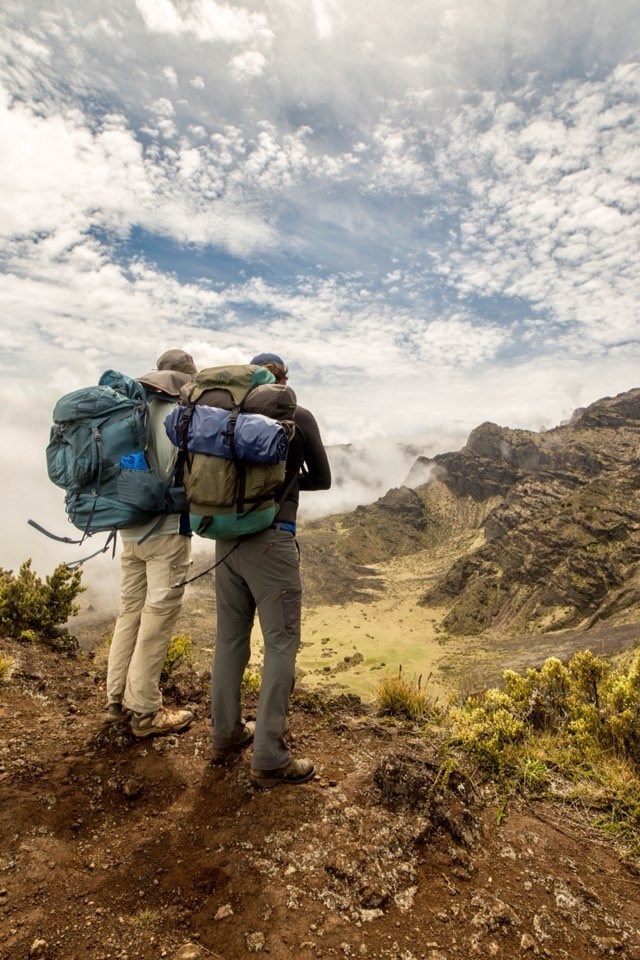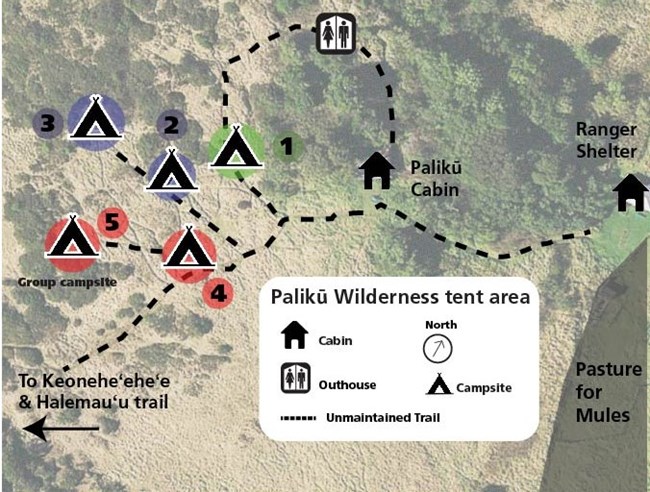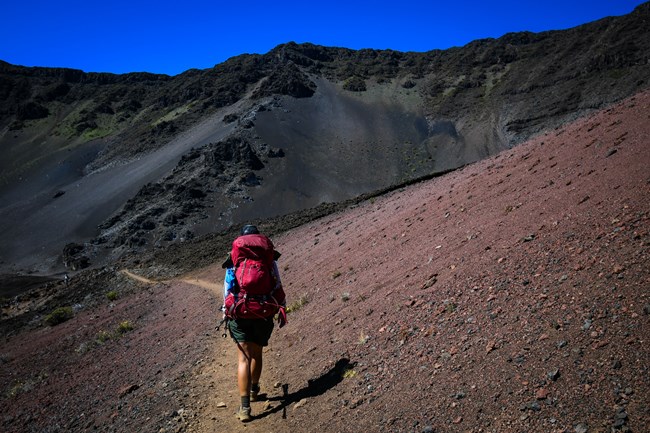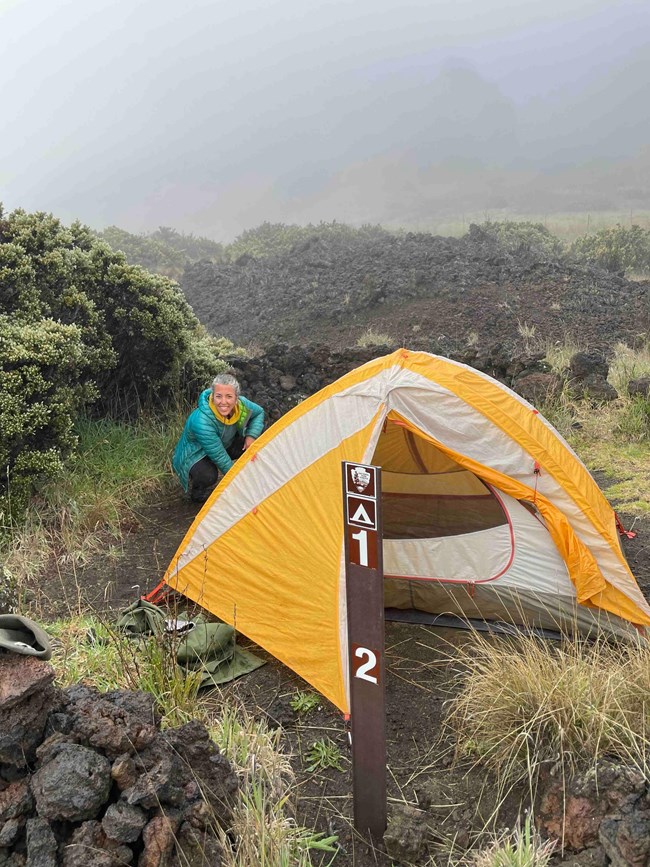Wilderness Tent Camping in Haleakalā National ParkThere are two primitive wilderness tent camping areas which are accessible only by trail, Hōlua and Palikū. Reservations are required for both campsites through www.recreation.gov. 
Joe Domrad
The requested video is no longer available.
Hōlua CampsitesHōlua, the wilderness campsite reached by the shortest hike, lies at 6,940 feet (2,115m) in the shrubland near Ko'olau Gap. Hōlua is 3.7 miles one way (6km) down the Halemau'u Trail or 7.4 miles one way (12km) from the Keoneheʻeheʻe (sliding sands) Trailhead. Visitors staying at Hōlua can enjoy day hikes into the central Wilderness Area. The landscape around Hōlua supports a native shrubland which colonizes the lava flows.
NPS Photo Hōlua Wilderness tent area sites are designated by brown stakes with arrows. Tents must be set up in the vicinity of the reserved site as denoted on the map. Campers are not required to camp directly next to the brown stake. To prevent increased use, please choose an already trampled spot to set up tents. Palikū CampsitesAt 6,380 feet (1,945m), Palikū is on the east end of the Wilderness valley at the base of a rain forest cliff. The campsite is reached via a strenuous 9.3 mile (15km) one way hike on the Keoneheʻeheʻe (sliding sands) Trail or 10.4 miles (17km) one way hike on Halemauʻu Trail. Clouds and fog often roll over the top of the cliffs behind Palikū, and rain is common. The extra moisture makes this spot exceptionally cool and lush. 
NPS Photo Permits are only valid for the sites reserved. Please have your permit printed for proof of site reservation. A reservation for a wilderness tent area does not grant access to the ranger shelter or the visitor cabin. 
NPS Photo Prepare for your tripIt is your responsibility to be aware of potential dangers and to take steps necessary to minimize the chance that you will become lost or injured. Enjoy your trip by coming prepared and using the following tips: Prepare for the Weather: The wilderness area is remote and experiences unpredictable weather. Temperatures vary from 40-70 degrees Fahrenheit during the day and 30-50 degrees Fahrenheit at night. Plan for rain at all times of year. If it is stormy, winds can exceed 80 miles per hour with temperatures dropping well below freezing. Terrain: Hiking trails may be steep. Terrain may include loose cinders and/or rocks. Sturdy hiking shoes are highly recommended. Change in altitude can be from a high of 9,780ft to a low of 6,380ft. Due to the soft sandy nature of the trails, plan on spending twice as much time to hike out as to hike in. Stay On-Trail: Protect fragile species found in the park by staying on the trail! Haleakalā is an on-trail park and all visitors required to stay on designated trails. Staying on trail not only helps fragile habitat but in addition keeps you safe as hiking off trail increases the potential for injury or becoming lost. Stay Together: When hiking with a group, keep track of each other by staying in sight of one another at all times. If separated wait along the trail, and especially at all trail junctions. Reminder: There is no cell phone service in Haleakalā Crater and it is very limited at trailheads. Share Your Itinerary with Someone You Trust: Let someone know your itinerary or trip plan and instruct them to contact emergency personnel if you are overdue. The park's emergency communication center's phone number is 808-985-6170. This number is for emergencies only! Make sure the person you designate understands that if you are overdue, lost, or injured on the trail, they are your only link to help and should report you overdue if you fail to contact them by a predesignated time. If Lost: If you become disoriented or lost, attempt to fix your location using a map, compass, and landmarks. If you are unable to locate the trail, stay put! Use a mirror or reflective object to signal for help. Any signal done three times in a series is a universal distress call. Bright colors and reflective materials to attract attention. If Sick of Injured: If you become ill or injured on the trail and are unable to hike, send someone in your party or a passing hiker for help. Write down and give the messenger your exact location, age, gender, height, weight, and a description of your illness/injury in order to ensure the appropriate emergency response. There is no cell phone service in Haleakalā Crater. Emergency signal devices work in the crater but should not be the only thing you rely on, remember to share your itinerary with someone you trust and instruct them to contact emergency personnel if you are overdue. Plan for the Best, Prepare for the Worst: Always carry extra food and water, rain gear, and warm clothing in case you have to spend the night out unexpectedly Loading...
Basic Information
Amenities Fire/Stove Policy Toilet Types Shower Types Weather Email Address Phone number (Voice) Mailing Address Physical Address Directions Additional Information Cell Phone Additional Information Internet Additional Information Regulations
Image Gallery
Accessibility Information

NPS Photo Help Us Protect the Crater Wilderness!All hikers are required to pack out everything they pack in. Do not bury your trash or discard it in pit toilets - pack it out. Practice "leave no trace". Natural & Cultural Resources Help us protect your National Park. All plants, animals, rocks and other natural and archaeological or cultural features are protected by law against removal, injury, or destruction.
Special Note: Wilderness Tent Reservation FAQsThe new system responds directly to public requests for an improved reservation process at park campsites and will help to ensure overcrowding does not occur in campsites during the COVID-19 Pandemic. Campsite reservations will allow for an enhanced visitor experience:
No, campsite reservations are only available online through recreation.gov.
Wilderness Haleakalā Crater campsites Palikū or Hōlua reservations cost $8 per reservation if booking online via Recreation.gov or $9 per reservation if booking via phone with Recreation.gov. All sites have a maximum stay of 3 nights in a 30-day period.
The rates cover the cost of online services and use of Recreation.gov. Reservations are available at a minimal cost. The National Park Service is required to ensure that rates charged to the public are reasonable for visitors and set in accordance with law and policy.
Overnight stays are limited to 3 nights total for all park areas in a 30-day period.
Sleeping in a vehicle is only allowed in a campsite registered to you or another member of your group. Sleeping in a vehicle in a parking lot or along the side of a road is prohibited.
Haleakalā National Park campsite online reservations with Recreation.gov will be open starting April 22, 2021, and may be utilized to reserve sites up to six (6) months in advance.
Yes, visitors must create an account on the Recreation.gov website prior to making campsite reservations. Those who already have an account are encouraged to confirm their login and password information. This is the same reservation site to obtain an advance wilderness cabin reservation and sunrise reservation in Haleakalā National Park.
No, campsite reservations are only available online. Same-day reservations may be available on recreation.gov due to any last-minute cancellations but visitors are urged to ensure they have a reservation prior to coming to the park before planning to stay overnight.
If cancellations occur or if a campsite remains available, visitors will be able to make “day of” reservations through Recreation.gov. Anyone camping in park campsites MUST have a reservation, with a confirmation email.
No, campsite reservations are non-transferable. Campsite reservations are only valid for the person who made the reservation and that person’s vehicle.
No, the campsite reservation fee only covers the cost of your reservation. For more information on park entrance fees, visit: Fees & Passes - Haleakalā National Park (U.S. National Park Service) (nps.gov)
Recreation.gov is a website and a tool to plan your next trip, figure out details, and reserve experiences at over 3,600 facilities and 103,000 individual sites across the country. The Recreation.gov mobile app puts adventure at your fingertips. From booking a sunrise reservation to planning a wilderness backpacking trip, the Recreation.gov app helps you find and reserve campsites, review location details, and quickly access information on past and upcoming reservations.
You may always contact us on our website. The superintendent’s office receives all comments about the online camping reservation system.
This system is temporary to address public health concerns resulting from the COVID-19 pandemic. The park is currently planning to operate this system in 2021 and will re-evaluate the need for the system based on public health guidance.
|
Last updated: October 15, 2024
